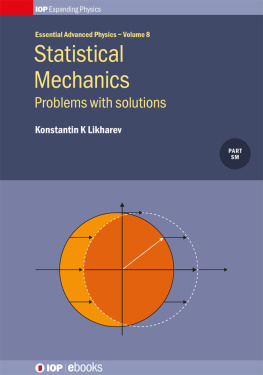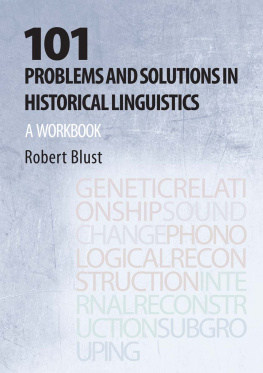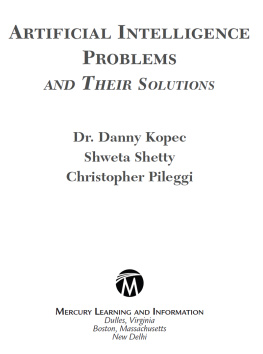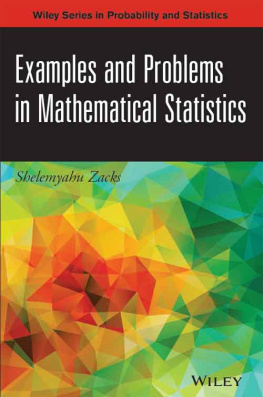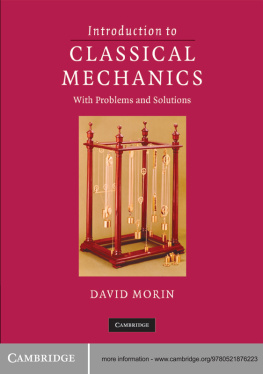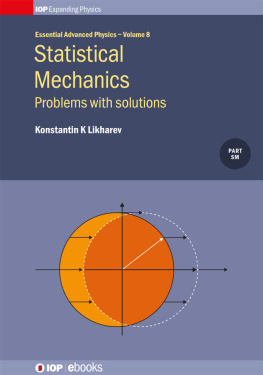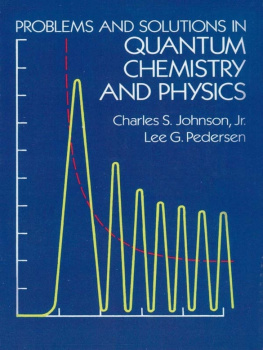Contents
Contents
Statistical Mechanics
Problems with solutions
Konstantin K Likharev
IOP Publishing, Bristol, UK
Copyright Konstantin K Likharev 2019
All rights reserved. No part of this publication may be reproduced, stored in a retrieval system or transmitted in any form or by any means, electronic, mechanical, photocopying, recording or otherwise, without the prior permission of the publisher, or as expressly permitted by law or under terms agreed with the appropriate rights organization. Multiple copying is permitted in accordance with the terms of licences issued by the Copyright Licensing Agency, the Copyright Clearance Centre and other reproduction rights organizations.
Permission to make use of IOP Publishing content other than as set out above may be sought at .
Konstantin K Likharev has asserted his right to be identified as the author of this work in accordance with sections 77 and 78 of the Copyright, Designs and Patents Act 1988.
ISBN 978-0-7503-1419-0 (ebook)
ISBN 978-0-7503-1420-6 (print)
ISBN 978-0-7503-1421-3 (mobi)
DOI 10.1088/2053-2563/aaf504
Version: 20190701
IOP Expanding Physics
ISSN 2053-2563 (online)
ISSN 2054-7315 (print)
British Library Cataloguing-in-Publication Data: A catalogue record for this book is available from the British Library.
Published by IOP Publishing, wholly owned by The Institute of Physics, London
IOP Publishing, Temple Circus, Temple Way, Bristol, BS1 6HG, UK
US Office: IOP Publishing, Inc., 190 North Independence Mall West, Suite 601, Philadelphia, PA 19106, USA
Preface to the EAP Series
Essential Advanced Physics
Essential Advanced Physics (EAP) is a series of lecture notes and problems with solutions, consisting of the following four parts:
Part CM: Classical Mechanics (a one-semester course),
Part EM: Classical Electrodynamics (two semesters),
Part QM: Quantum Mechanics (two semesters), and
Part SM: Statistical Mechanics (one semester).
Each part includes two volumes: Lecture Notes and Problems with Solutions, and an additional file Test Problems with Solutions.
Distinguishing features of this seriesin brief
condensed lecture notes (250 pp per semester)much shorter than most textbooks
emphasis on simple explanations of the main notions and phenomena of physics
a focus on problem solution; extensive sets of problems with detailed model solutions
additional files with test problems, freely available to qualified university instructors
extensive cross-referencing between all parts of the series, which share style and notation
Level and prerequisites
The goal of this series is to bring the reader to a general physics knowledge level necessary for professional work in the field, regardless on whether the work is theoretical or experimental, fundamental or applied. From the formal point of view, this level (augmented by a few special topic courses in a particular field of concentration, and of course by an extensive thesis research experience) satisfies the typical PhD degree requirements. Selected parts of the series may be also valuable for graduate students and researchers of other disciplines, including astronomy, chemistry, mechanical engineering, electrical, computer and electronic engineering, and material science.
The entry level is a notch lower than that expected from a physics graduate from an average US college. In addition to physics, the series assumes the readers familiarity with basic calculus and vector algebra, to such an extent that the meaning of the formulas listed in appendix , Selected mathematical formulas (reproduced at the end of each volume), is absolutely clear.
Origins and motivation
The series is a by-product of the so-called core physics courses I taught at Stony Brook University from 1991 to 2013. My main effort was to assist the development of students problem-solving skills, rather than their idle memorization of formulas. (With a certain exaggeration, my lectures were not much more than introductions to problem solution.) The focus on this main objective, under the rigid time restrictions imposed by the SBU curriculum, had some negatives. First, the list of covered theoretical methods had to be limited to those necessary for the solution of the problems I had time to discuss. Second, I had no time to cover some core fields of physicsmost painfully general relativity and quantum field theory, beyond a few quantum electrodynamics elements at the end of Part QM.
The main motivation for putting my lecture notes and problems on paper, and their distribution to students, was my desperation to find textbooks and problem collections I could use, with a clear conscience, for my purposes. The available graduate textbooks, including the famous Theoretical Physics series by Landau and Lifshitz, did not match the minimalistic goal of my courses, mostly because they are far too long, and using them would mean hopping from one topic to another, picking up a chapter here and a section there, at a high risk of losing the necessary background material and logical connections between the course componentsand the students interest with them. In addition, many textbooks lack even brief discussions of several traditional and modern topics that I believe are necessary parts of every professional physicists education.
On the problem side, most available collections are not based on particular textbooks, and the problem solutions in them either do not refer to any background material at all, or refer to the included short sets of formulas, which can hardly be used for systematic learning. Also, the solutions are frequently too short to be useful, and lack discussions of the results physics.
Style
In an effort to comply with the Occams Razor principle, I have made every effort to make the discussion of each topic as clear as the time/space (and my ability :-) permitted, and as simple as the subject allowed. This effort has resulted in rather succinct lecture notes, which may be thoroughly read by a student during the semester. Despite this briefness, the introduction of every new physical notion/effect and of every novel theoretical approach is always accompanied by an application example or two.
The additional exercises/problems listed at the end of each chapter were carefully selected, so that their solutions could better illustrate and enhance the lecture material. In formal classes, these problems may be used for homework, while individual learners are strongly encouraged to solve as many of them as practically possible. The few problems that require either longer calculations, or more creative approaches (or both), are marked by asterisks.
In contrast with the lecture notes, the model solutions of the problems (published in a separate volume for each part of the series) are more detailed than in most collections. In some instances they describe several alternative approaches to the problem, and frequently include discussions of the results physics, thus augmenting the lecture notes. Additional files with sets of shorter problems (also with model solutions) more suitable for tests/exams, are available for qualified university instructors from the publisher, free of charge.
Disclaimer and encouragement

